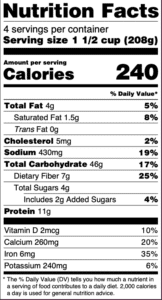
Nutrition labels are present on the back or side of packaging in most of the pre-packaged goods. The goal of displaying them is to guide consumers in food selection.
These labels include information about how much energy, proteins, fats (saturated, unsaturated, trans), carbohydrates, sugars, fiber, salt, vitamins, and minerals are present in the product. All nutrition information is provided per 100 grams and sometimes per portion.
Nutrition labels help you choose healthy foods but the question is how to read them, how to know what should be consumed, and in what quantity. Let’s find out.

The first column in nutrition labels reflects serving information. It contains number of servings and serving sizes. Serving size depicts the amount or quantity people generally consume. It does not recommend how much portion should be consumed. All the nutrients mentioned in the nutrition label are calculated as per the serving size. Let’s understand it through an example, a pre-packaged chocolate drink mentions 200ml as 1 serving and contains 100kcal so If a person consumes 0.5 servings of that drink then they are taking 100ml of it. Understanding serving information is important to monitor daily nutrient requirements.
Calories provide a measure of how much energy you get from a serving of this food. For ex- a serving of the above-mentioned chocolate drink contains 100kcal, so if you are drinking 1 serving of it you will be getting 100kcal from it or if you are consuming 2 servings of it then you are getting 200kcal. Taking a look at the calorie column and analyzing it is important to balance it with your daily calorie requirements.
The nutrition label section contains some key nutrients that impact your health. You should choose the products that contain the nutrients that you require to support overall health and eliminate/avoid products that contain nutrients you may want to limit. It is of 2 parts-
Dietary fibre, vitamin D, calcium, magnesium, vitamin B, iron etc. These are the nutrients that most people do not get in recommended amounts. Dietary fiber helps in digestion and other nutrients help keep the bones healthy and bp in check.
Saturated and trans fat, sodium, and sugar. Foods high in these nutrients lead to obesity, diabetes, hypertension, etc. Sugars are of two divisions total sugars and added sugars.
* Total sugars- These include sugar that is naturally present in food and beverages like sugar in fruits or milk as well as added sugars that may be present in the product.
* Added sugar- these include sugars that are added during the processing of the product (dextrose, maltose), artificial sweeteners (stevia, aspartame), honey, syrups, fruit juices. Avoid any product if it is high in any kind of these sugars, and beware of the hidden sugars that some brands can trick you with by labeling them as “sugar-free”.
* The hidden sugars (check the ingredients list) can be in the form of inverted sugar, maltodextrin, maple syrup, galactose (names ending with ose) in the nutrition label.
a. Organic- organic means food produced by organic farming but that doesn’t always mean healthy as most food items are produced organically, what makes it healthy is lesser processing that is done between extracting raw material/food and distribution of the final product.
b. No added sugar- this simply means that the product does not have sugar or sugar substitutes like syrups, artificial sweeteners, stevia, etc present in it.
c. Zero trans fat- it signifies that less than 0.5gms of trans fat per serving is present in it. Therefore a clear understanding of serving size is important (if the mentioned serving size is very little then you might still be consuming trans fat.
d. Gluten-free- any product that does not contain wheat, rye, or barley is gluten-free. But that doesn’t make it healthier. Gluten-free products are only beneficial to people who are gluten intolerant
e. Low fat / low carb- low fat / low carb diets are on-trend these days and are deemed healthy but these foods are still unhealthy if they are highly processed or high amounts of salt or sugar have been added to them.
It is very important to understand that in order to be healthy we need to avoid processed foods. Whole foods are the part of out balanced diet and should be consumed majorly. And guess what, you don’t even need to think if it’s healthy or not because all whole foods are healthy!
In case there is any need to consume packaged foods then be aware of the above-mentioned list. Make sure that you limit the products that have misleading labels.